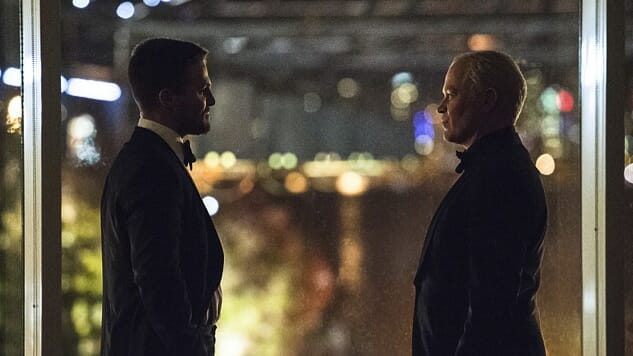Arrow: “Brotherhood”
(Episode 4.07)

One gets the sense that “Brotherhood” is an episode that very well could have come earlier in Arrow’s run. If this hour is any indication, however, it’s that sometimes good things come to those who wait. Certainly, the mystery surrounding the death of Diggle’s brother, Andy, has been a long-simmering story point in the show’s ever-expanding mythology. It’s endured through Deathstroke’s rise and fall, Ra’s al-Ghul’s reign of terror as well as the death and resurrection of Malcolm Merlyn, Sara and Thea. And though much of the episode proves to be a showcase for David Ramsey, who beautifully rises to the occasion, it also serves as an effective exchange of ideas—the kind that, in many ways, can only exist in the latter years of an established show.
As we enter our story, Diggle reveals his brother’s dark, secret file to Oliver. It’s here that the divide between the two’s ideologies are put into stark contrast. Whereas the military-bred and logical Diggle believes the hard evidence put in front of him, Oliver—who has both seen and experienced his fair share of grey moral shadings—is more inclined to believe not all may be as it appears.
This dilemma reaches new heights when Team Arrow intervenes in another attack from Dahrk’s “ghost” army and Diggle discovers that one of the masked men is Andy, alive and well. Diggle’s feelings are…complicated, to say the least. The rest of Team Arrow is quick to point out the obvious positives— Diggle finally has his brother back. Naturally, Diggle doesn’t see things in quite the same light. In his mind, the Andy they’ve discovered is not the loving brother he once thought he knew. Rather, he’s a traitor who betrayed his moral obligations and abandoned his family for eight years, putting them through unimaginable mental anguish. Given the love Diggle has shown for his own wife and child, it’s understandable that such an action feels unforgivable to him.
-

-

-

-

-

-

-

-

-

-

-

-

-

-

-

-

-

-

-

-

-

-

-

-

-

-

-

-

-

-

-

-

-

-

-

-

-

-

-

-








































